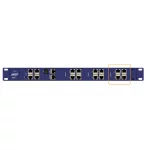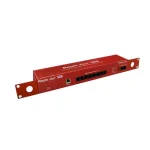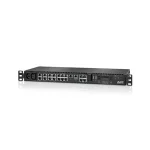MAC stands for Media Access Control. A MAC address is a unique identifier assigned to a networkable product such as a data centre environment sensor monitoring device. A MAC address is used in IEEE 802 networking technologies such as wired Ethernet, Wi-Fi and Bluetooth.
Data Centre Temperature Monitoring
Data Centre Temperature Monitoring is a critical requirement when it comes to managing a data centre environment. The right temperature levels helps to ensure the overall reliability of the critical IT servers and networking infrastustructure and optmise energy usage. To monitor data centre temperature levels, temperature sensors must be placed within key areas of the data centre including server racks, hot and cold aisles and areas where hot-spots can occur. These sensors are then wired to a base environmental monitoring device which will act as data loggers, sending the data to montoring software platforms (on-premises and cloud) and trigger alert notifications via email, SMS and phone calls.
-
Applications (40)
- Temperature & Humidity (30)
- Water Leakage Detection (26)
- Server Rack Monitoring (28)
- Hardwired Ethernet Devices (28)
- Wi-Fi Connectivity Units (8)
- Wireless Devices (13)
- Narrowband IoT Devices (4)
- GSM / LTE Comms (7)
- Battery Monitoring (7)
- Power Monitors (28)
- Security Monitors (26)
- Branch Circuits (2)
- Data Centres (7)
- Data Loggers (11)
- Data Aquisition Systems (11)
- Laboratories (18)
- Pharmaceutical (18)
- Accessories (159)
Temperature Monitoring in Data Centers
There are several advantages to temperature monitoring in data centres. The two principle area equipment uptime and energy usage. Setting the right temperature level lowers the amount of energy used by the cooling system and helps to ensure that IT hardware is not heat-stressed.
The Importance of Temperature Monitoring
- Server Performance: IT servers and other networking hardware components generate a significant amount of heat. If the temperature rises too high, this can lead to hardware failures, slow performance, or even data loss.
- Energy Efficiency: the more energy efficient the cooling system, the lower the running costs and power usage effectiveness (PUE) ratio.
- Compliance and Standards: various industry standards and best practices, such as those outlined by ASHRAE (American Society of Heating, Refrigerating, and Air-Conditioning Engineers), recommend specific temperature and humidity ranges for data centres. These help ensure equipment runs at optimal efficiency.
- Preventing Downtime: Overheating can cause servers to throttle down or shut off, leading to unexpected downtime. Temperature monitoring helps prevent this.
The Right Temperature Range for a Data Centre
The recommended temperature range for a data centreis typically between 18°C and 27°C (64°F to 81°F). toThe arrangement of server racks in hot aisle/cold aisle configurations can help to improve cooling efficency Cold air is directed toward the front of the servers (intakes), while hot air is exhausted at the back.
It is also important to monitor humidity levels and some sensor manufacturers supply combined temperature & humidity sensors. The recommended humidity level should lie between 45% and 60% to prevent static electricity buildup and corrosion. High humidity can indicate a problem with the air conditioning system.
Airflow sensors near air cooling systems can also be deployed. These are two types: the first simply monitors for the presence of air flow and the second, the volume of air flow as well as its presence. No airflow or a reduced airflow indicates a problem with the cooling system.
Temperature Monitoring Methods
There are several ways to monitor temperature monitoring in a data centre.
- Environmental Sensors: temperature sensors are placed throughout the data center to monitor ambient temperature in various locations. For example in and near server racks, air conditioning units, and cooling systems.
- Real-Time Monitoring Systems: advanced monitoring solutions provide real-time data about temperature, humidity, and airflow. These systems often include alerts when the temperature goes beyond preset thresholds.
- Data Loggers: These are used to collect temperature data over time, which can be useful for trend analysis and identifying potential issues before they become critical.
- Integrated Cooling Systems: automated cooling systems can be integrated with temperature monitoring to adjust cooling efforts dynamically depending on the conditions in the data centre.
Data Centre Temperature Mapping
Hot areas within a data centre environment can present fire risks. The most likely area for a localised hot-spot is wihtin a server rack. For this reason it is recommended to install temperature sensors at the top, middle and bottom of the server rack and to repeat this layout at the front and rear of the cabinet. This sensor condiguration will help to identify hot-spots and helps to monitor overall cooling efficiency. A combined temperature & humidity sensor is the preferred sensor choice as this can also help to create a thermal mapping of the data centre server racks which can be used if temperature mapping, modelling, CFD analysis and even digital twins.
Data Centre Monitoring Software
Some data centres run data centre infrastructure management (DCIM) packages and environmental monitoring base units should be able to support these through standard protocols including SNMP or MQTT. Typical DCIM packages include:
- 8Device42: recognized for its comprehensive auto-discovery and device tracking capabilities, Device42 offers real-time insights into IT assets, interdependencies, and network configurations. Its intuitive dashboard and powerful search functions enhance infrastructure management.
- Nlyte Software: Nlyte provides robust solutions for planning, managing, and optimizing data centers. Features include asset management, capacity planning, and integration with various IT service management tools, facilitating efficient resource utilisation and operational excellence.
- Sunbird DCIM: Sunbird’s DCIM solutions focus on data center monitoring and management, offering tools for power management, environmental monitoring, and asset tracking. Its user-friendly interface and real-time data visualization aid in effective decision-making.
- Schneider Electric EcoStruxure IT: EcoStruxure IT ensures business continuity through secure monitoring, management, and optimization of data center infrastructure. It supports both cloud-based and on-premises deployments, providing real-time monitoring, asset tracking, and capacity optimisation.
- Vertiv Trellis: Trellis is a DCIM solution tailored to monitor and manage cooling and power systems within IT environments. Its emphasis on optimizing these critical aspects ensures efficient data center operations with reduced overhead costs.
- Paessler PRTG Network Monitor: this is a comprehensive network monitoring solution that offers features similar for Data Center Infrastructure Management (DCIM). While it may not be a traditional DCIM tool, PRTG provides extensive monitoring capabilities that can be applied to data center environments.
Monitoring System Manufacturers Software
Each of the device manufacturers we work with also supplies their own monitoring software that can be used to monitor the logged data, provide a dashboard and historical analysis and manage alert notifications and their distribution.
Manufacturer Hardware Device Software Platform AKCP sensorProbeX+ AKCPro Server Software APC by Schneider NetBotz EcoStruxure Avtech Room Alert Room Alert Manager HW Group Perseus HWg Cloud or SensDesk The software packages are generally clouud-based with options for on-premises installation.
Please contact our projects team for a specification review and discussion on how we can install and configure the right temperature monitoring system for your data centre.

Earn SRE points on all online purchases with double points on selected products







































